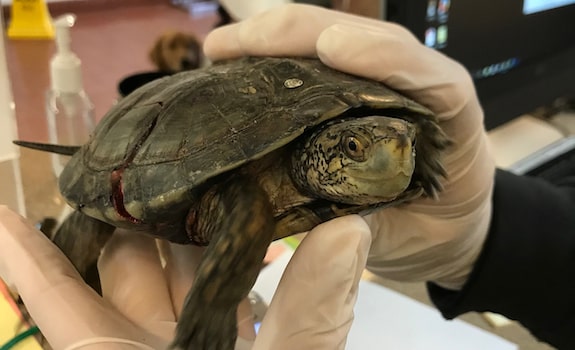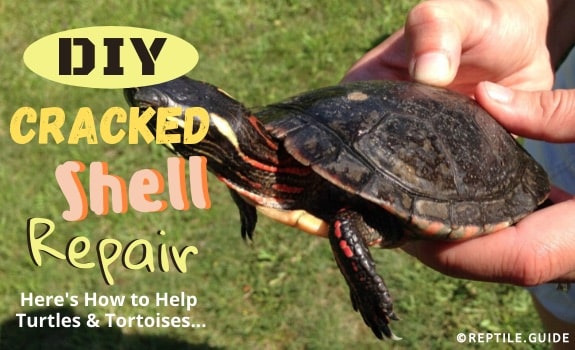Perhaps your turtle or tortoise just got attacked by the dog. Or maybe you’ve recently found a turtle or tortoise that has been hit by a car on the road?
Regardless of the specifics, all of these instances can cause a turtle or tortoise to crack their shell.
Fortunately, many times these cracked shells can be easily fixed at home. However, sometimes injuries need to be seen by a vet that specializes in exotic animals.
So, which predicament does your specific turtle or tortoise fall under? DIY at home cracked shell repair or a trip to the vet?
To understand how to do to fix a cracked shell repair from home or the signs that a trip tot he vet is in order, just keep reading!
In This Article
Can a Turtle Survive with a Cracked Shell?
Many turtle and pet tortoises can in fact survive with a cracked shell. Even those with a very severe shell fracture, if given proper attention and allowed to rest and recover, will do just fine.
Now, if you find a turtle or tortoise whose shell has been through extensive damage, so much so that large pieces are missing or organs are hanging out of the cracks, these usually do not survive.
Even though the damage that you see on the outside may not be very severe, these shells are there to protect their organs. By cracking their shells, they are also causing damage to organs inside.
Many times, all you need to do is give these turtles or tortoises a little care and attention to save their life. You can easily nurse them back to health and even release them back into the wild.
⭐️Fun Fact: Did you know, that it’s a common misconception that a turtle or tortoise can come out of its shell? You see, both a turtle and a tortoise are fused into their shell which comprises part of their skeletal system. As both creatures grow, so too does their shell to accommodate their body size.
Common Causes of Broken or Cracked Shells
There are many ways that your turtle or tortoise can crack their shells. These are just some of the most common reasons that they may have cracked or broken their shell…
They Were Attacked By a Dog
If your dog finds a turtle or tortoise running around the in the backyard, they may think this is a new chew toy.
Even though turtles and tortoises have a very hard shell, many dogs’ teeth can cause still cause damage. Larger breeds such as Akita and Doberman possess enough power in their jaws to actually break bones, so it shouldn’t be too surprising they can break shells as well.
They Were Fighting with Others
Some turtles or tortoises can be very aggressive towards each other. They can even push each other into things and cause them to break their shell.
The problem lies in that turtles and tortoises are relatively solitary creatures. This means they don’t have strong social ties within their species and this is especially true with sexually mature males!
They Escaped From Their Cage
Some turtles and tortoise are natural escape artists. And unfortunately, this secret talent only becomes apparent after they’ve gotten out!
Often times, when they escape, they can tumble and fall from a very high height causing them to break their shell.
They Were Accidentally Dropped
While everyone naturally tries to be very careful when they are moving their turtle or tortoise, accidents can always happen.
Sometimes this is because your turtle or tortoise is wiggling when you are carrying them, causing you to drop them. Sometimes a child may pick them up and not be strong enough to carry them and as a result drops them.
Whatever the case, try to exercise extreme caution when carrying your pet and ensure your children know to leave the heavy lifting to adults only.
They Were Hit By a Car

Let’s face it… wild turtles and tortoises are NO match for a car. I mean, truly what animal is?
Many times, turtle or tortoises are not seen by oncoming drivers as they are trying to cross the road. And as a result of this, they may accidentally get hit.
Sometimes these are very big fractures and other times these are just small cracks on the side.
Cracked Shell Repair: Here’s How to Help…
So, now that you understand some of the ways in which a turtle or tortoise can crack their shell, let’s jump into how you can perform a DIY at home cracked shell repair!
Step # 1: Clean the Wound
For minor damages, you can easily treat them at home. If there is any blood or dirt on your turtle’s shell, you will need to clean the shell.
Use cleaners such as chlorohexidine solution or diluted Iodine to clean the wound a few times a day. You will continue this cleaning for about one week or until all the dirt and debris are clearly out of the wound.
Keeping the wound clean will not only help speed up the overall healing process, but will discourage other conditions such as shell rot from happening.
Step # 2: Keep Them Dry
If your turtle lives in any water, you need to keep them dry until their shell heals. Water from their tank can cause bacteria and debris to continually enter the cracks.
Step # 3: Give Antibiotics if Needed
If there are large defects or large infections in the cracks, your turtle or tortoise will require antibiotics. Commonly used antibiotics are Baytril or ceftazidime, which can be prescribed by a veterinarian.
You turtle or tortoise will be on antibiotics and cleanings for about one week to make sure all the infection is out.
🤓Expert Tip: If your turtle or tortoise requires antibiotics, it is crucial that you administer them for at least 1 week. Infections that are still present when the fractures begin to close will only be allowed to fester. The essentially “trapped” infection will inevitably cause your turtle or tortoise to get very sick.
Step # 4: Fix Any Large Cracks
Fixing large openings or crack should be left up to an exotic vet as they are the ones whom have plenty of experience in this department.
There are many different ways that they may choose fix the crack, and all methods will rely primarily on the location and size of said crack or cracks.
Some will need wires, and others may just need a few zip-ties that glue on top of the shell to hold the pieces back in place.
Step # 5: Apply a Fiberglass Patch
A turtle and tortoise safe fiberglass patch will be used to cover up any cracks or depressions on the shell. This patch will need to be adhered to their shell with glue. You may need to put a few coats on for the fiberglass patch to stay stuck to the shell.
After attaching the fiberglass patch to the shell, you will need to ensure they’re in an area where things can’t attach and get stuck to the glue.
It is best to keep them on a clean surface, such as in plastic containers, with nothing on the bottom until they are no longer sticky to touch.
Step # 6: Apply Resin
After a few days of drying, you can apply the resin to their shell. This will keep water from getting into the wound.
This is a crucial step for aquatic turtles or any tortoise that could get wet. Similar to after gluing the fiberglass, you’ll want to once again provide a few hours of drying time on a clean surface.
Step # 7: Allow Drying Completely
Before you can put your turtle or tortoise back into their enclosure and allow them to get wet or release them back into the wild, you need to make sure that their shell is completely dried.
Usually waiting about one week after applying the resin to their shell will be enough time to make sure that the resin is 100% dry.
⭐️Fun Fact: Did you know, “Carapace” is the name given to the top part of a turtle’s shell? Meanwhile the bottom portion is called the “plastron”. Both of these pieces combined account for roughly 60 bones and function as a type of external ribcage of sorts that protect the turtle from bottom to top.
Step # 8: Return Them to Normal
After they have completely dried, you can return them to their normal enclose. However, it should be noted that their shell can take up to a few years to fully heal.
Now, if your turtle or tortoise is very young, they will very likely need the fiberglass patch and resin reapplied. They will quickly outgrow this covering in a few months. Keep an eye on your turtle or tortoise for when it is time to reapply.
The main thing to remember when putting a patch on your turtle or tortoise is that you want to make sure that you are NOT getting epoxy or other material in the wounds.
You also want to make sure that you are not sealing off an infection under your patch, as aforementioned.
When to See an Exotic Vet

For very serious damage, including puncture wounds from an animal bite or any wound that is bleeding, you need to take your turtle or tortoise to the vet ASAP!
The reason? Unfortunately, many of these wounds can easily get infected. And should this happen, the infection may be able to spread throughout your turtle or tortoise’s body.
In severe cases that are left untreated, it is not uncommon for there to be extensive internal damage that the human eye simply cannot see.
Your vet can clean the wounds for you, cover them, and start them on a course of antibiotics to help prevent infection. They will also thoroughly examine your turtle or tortoise for any signs of internal damage or other problems.
Depending on your situation, your vet may also repair the damaged shell. Larger shell wounds will require fully rebuilding the shell using small pieces of fiberglass and epoxy resin or other materials.
After the shell has a patch, the shell can then heal under these patches.
You should especially enlist the help of your vet to repair serious shell damage. The severe shell damage can make it difficult to ensure the wounds are clean without causing even more damage to your turtle or tortoise.
At the end of the day, it is always best for your vet to examine your turtle or tortoise for any signs of internal damage.
Your vet can evaluate if the turtle or tortoise has been damaged beyond repair and if humane euthanasia is a better option so that your turtle or tortoise does not suffer.
How Long Does It Take for a Shell Crack to Heal?
Turtle and tortoise shells grow at a very slow rate and can take months to heal if not years to properly heal.
The underlying soft tissue injuries usually heal in 2 to 3 weeks, where the shell fractures can easily take 4 to 18 months to become fully stable.
Wrapping Up Cracked Shell Repair
Sometimes your turtle or tortoise can damage their shell on their own. Other times, you, a loved one, the family dog, or another can accidentally inflict the damage.
Nonetheless, regardless of the damage, you will need to clean the wound then use fiberglass or epoxy to help hold the two pieces together so that they can heal.
Sometimes, this is best left to your vet but often times small cracks can be repaired from home by simply following the DIY cracked shell repair steps listed above.
With enough luck, patience, and love… you should be able to help the turtle or tortoise heal.
